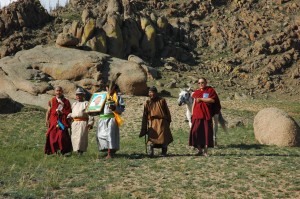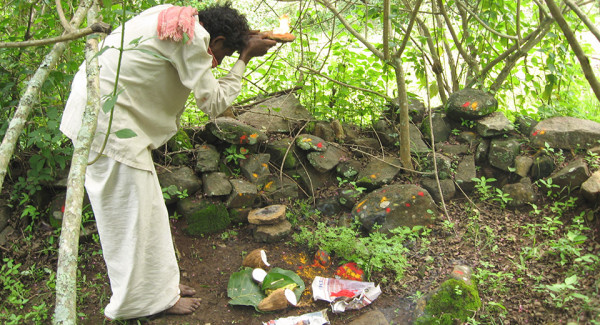
គេហទំព័រធម្មជាតិពិសិដ្ឋអាស៊ី: អានទស្សនវិជ្ជាបុរាណនិងការអនុវត្តអាស៊ីសារៈសំខាន់ជាមូលដ្ឋានដើម្បីនៅជាមួយតំបន់ការពារ. (ទាញយកការហៅនេះ)

របស់ Bogd ខណ្ឌម៉ុងហ្គោលីតំបន់ការពារត្រូវបានភ្ជាប់ជាមួយជីវិតរបស់ Ghengis ខណ្ឌនិងជាតំបន់ធម្មជាតិពិសិដ្ឋការពារជាតិចាប់តាំងពី 1778. ឥឡូវនេះវាគឺជាផ្នែកមួយនៃតំបន់ការពារភ្នំ Khentii នេះខណ្ឌទូលំទូលាយ. បន្ទាប់ពីរយៈពេលជាច្រើនឆ្នាំនៃការបង្រ្កាបកុម្មុយនិស្ត, ពិធីត្រូវបានគេឡើងវិញបានដឹកនាំពុទ្ធសាសនាក្នុងស្រុកខ្ញុំលុក. ពិធីនេះបានគោរពដល់អាទិទេពនៃភ្នំនិងញត្តិប្រឆាំងនឹងគ្រោះរាំងស្ងួតនិងព្រិលធ្លាក់ខ្លាំង. ខាងក្រោមនេះជាក្រុមដែលដំណើរការពិធីបុណ្យនៅផ្នែកពិសិដ្ឋបំផុតនៃភ្នំនេះ, កំពូល, ដឹកនាំដោយព្រះសង្ឃត្រឡប់មកវិញ. មនុស្សទីបីពីខាងឆ្វេងគឺលោក. ក្រុមហ៊ុន J. Boldbaatar, នាយក, ខណ្ឌ Khentii ពិសេសការពារតំបន់និងនៅលើខាងស្តាំរបស់គាត់អនុរក្សឧទ្យានថ្ងៃទីសម័យទំនើប (ឃើញករណីសិក្សានៅក្នុងគោលការណ៍ណែនាំរបស់អង្គការ IUCN អង្គការយូណេស្កូ). រូបថត: លោក Robert ព្រៃ.
Within the context of the Asian Sacred Sites Network Project, អង្គការ IUCN WCPA ជប៉ុន, នេះ បណ្តាញជប៉ុនជីវចំរុះ និង គេហទំព័រធម្មជាតិពិសិដ្ឋ Initiative in collaboration with the IUCN WCPA Specialist group on Cultural and Spiritual Values of protected Areas invite abstracts for contributions to a publication and online case studies focused on the modern significance of sacred natural sites in Asian protected areas with reference, ដែលជាកន្លែងដែលសមស្រប, ទៅទស្សនវិជ្ជាអាស៊ីមួយនៃតំបន់ការពារ. We are looking for examples from all protected area governance types; indigenous and community conserved areas, government managed, privately managed and co-managed protected areas as well as different IUCN protected area categories, ពី; ‘Ia Strict nature reserve’ to ‘VI. ‘Protected area with sustainable use of natural resources’. We are also interested in experiences that describe the implementation of the IUCN-UNESCO Sacred Natural Sites, គោលការណ៍ណែនាំសម្រាប់ការគ្រប់គ្រងតំបន់ការពារ, available in several languages.
As a guide to developing your contribution to the publication you may follow the guiding questions outlined in this call and write freely or base you contribution on the structure provided in the case study template that will be used for developing online case studies.
ការណែនាំសំណួរ:
- To what extent do sacred natural sites form the backbone of protected areas in Asia, ឧ. វប្បធម៌របស់ពួកគេ, ការទ្រទ្រង់ខាងវិញ្ញាណនិងទស្សនវិជ្ជា?
- What is the modern relevance of sacred natural sites to protected areas and how can this be better recognised and their traditional guardians be engaged?
- តើយើងអាចធ្វើឱ្យប្រសើរឡើងនូវប្រសិទ្ធភាពគ្រប់គ្រងយ៉ាងដូចម្តេច, governance and equity of sacred natural sites within and outside protected areas in Asia?
ប្រភពឯកសារយោង:
- នេះ Asian Philosophy of Protected Areas
- នេះ Asian Sacred Natural Sites Network project
- គោលការណ៍ណែនាំដែលល្អបំផុតលេខ 1: គេហទំព័រធម្មជាតិដ៏ពិសិដ្ឋ - គោលការណ៍ណែនាំសម្រាប់អ្នកគ្រប់គ្រងតំបន់ការពារ,
- អង្គការ IUCN 2008 គុណភាពបង្ហាញ 4.038 ការទទួលស្គាល់និងការអភិរក្សនៃតំបន់ធម្មជាតិពិសិដ្ឋនៅក្នុងតំបន់អភិរក្ស
- wcc-2012-rec-147 ទីតាំងធម្មជាតិដ៏ពិសិដ្ឋ - ការគាំទ្រសម្រាប់ពិធីសារថែរក្សាពិធីសារថែរក្សានិងច្បាប់ទំនៀមទំលាប់ប្រឈមនឹងការគំរាមកំហែងនិងបញ្ហាប្រឈមសកល.
Publication schedule:
Abstracts or your outline of ideas for your contribution can be submitted untill September, 2014 and should not exceed 400 words. The final manuscripts of approximately 4000 words (excluding references) will be required by November 2014 and should include up to eight good quality illustrations and photos as well as one or two maps. the aim is to have the publication launch coincide with activities on sacred natural sites and protected areas at the World Parks Congress in Sydney Australia.
Online case studies schedule:
Suggestions for online case studies are always welcome. A case study will be around 1000 words and can be based on your contribution to the publication or stand by itself. We aim to develop each chapter contribution to the publication into an online case study and establish cross-references. For examples of Asian case studies see the Asian Sacred Natural Sites Network Project.
Please send your abstracts and bio to info@sacrednaturalsites.org

A Soliga paying his obeisance at Devaru sacred natural site in Biligiri Rangaswamy Temple Wildlife Sanctuary, Karnataka, ប្រទេសឥណ្ឌា. បន្ទាប់ពីការប្រកាសរបស់ BRTWS នៅក្នុង 1974, ច្បាប់ថ្មីបានធ្វើឱ្យការអនុវត្ត Soliga ប្រពៃណីកាន់តែពិបាកនិងពិបាក, ជាឧទាហរណ៍ តាមរយៈការរឹតបន្តឹងការចូលទៅកាន់កន្លែងធម្មជាតិដ៏ពិសិដ្ឋរបស់ពួកគេ។. Following a ruling by the country’s Supreme Court in 2006, ការហាមឃាត់ជិតពេញលេញត្រូវបានដាក់លើការប្រមូលអនុផលព្រៃឈើនៅក្នុងដែនជម្រកសត្វព្រៃ និងឧទ្យានធម្មជាតិ. In a response to this, the Soliga GPS’ed and mapped their sacred and cultural sites in the forests of the Biligiri Rangaswamy Temple Wildlife Sanctuary. The topographic sheets with sacred natural sites on it were used to help locate the clan boundaries followed by subsequent visits to ascertain the boundaries of the yelles or sacred natural sites. (ប្រភព: នីទីន, បណ្ឌិត រ៉ៃ។)






